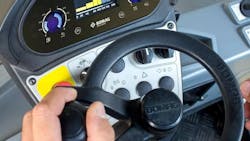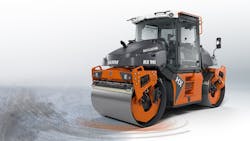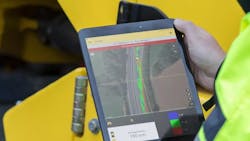What to Look for in Intelligent Compaction
Key Highlights
- Benefits of intelligent compaction.
- How intelligent compaction works.
- Key efficiencies gained with intelligent compaction.
The California Department of Transportation (Caltrans) defines intelligent compaction (IC) as “the compaction of road materials, such as soils, aggregate bases, or asphalt pavement materials, using rollers equipped with measuring devices, displays, and data acquisition system, allowing the construction staff to view real-time compaction data.”
Taking that definition into the iron, intelligent compaction rollers are “vibratory steel drum rollers equipped with accelerometer, temperature sensors, GPS, displays, and a documentation and feedback control system that processes compaction data in real-time for the roller operator,” according to Caltrans.
How compaction data are used
Key benefits of intelligent compaction
The benefits of IC are both direct and indirect. Hamm and Caltrans point out direct advantages.
- Homogeneous compaction
- No under- or over-compaction
- Less surface damage
- Lower emissions and diesel consumption
- Improved density
- Increased productivity
- Reduction of highway repair costs
- Continuous record of material stiffness values
- Identification of non-compactable areas
- Improved depth of compaction
- Reports to operator/fleet manager/project owners
Caterpillar focuses on operator and worker benefits, as well as component wear:
- Improved project quality and faster completion time because operators can confirm that they are achieving compaction right in the cab
- Less component wear because it takes fewer equipment hours to reach compaction targets
- Enhanced safety because there is less need for ground personnel to check compaction.
The data can be post-processed to create a compaction quality report. Intelligent compaction rollers facilitate real-time quality control for compaction by monitoring roller passes, surface temperature, and material stiffness that allow for timely adjustments to the compaction process.
Intelligent compaction rollers maintain a continuous data record of precise location of the roller using GPS, the number of roller passes, and material stiffness measurements.
According to Ebi Fini, senior transportation engineer at Caltrans, the data can be processed using FHWA Veda software to create a daily compaction quality control report to ensure that specification-required roller passes, material temperature, and material stiffness based on material density are met.
Intelligent compaction is also used to map the stiffness of the underlying material to establish the baseline stiffness of the materials and to identify areas of weak support. On a new construction project, mapping will be conducted on the in-place materials (soils and/or aggregate) base materials, Fini said.
Where a hot-mix asphalt (HMA) overlay is being placed over an existing asphalt pavement, mapping will be conducted on the existing asphalt pavement or on the pavement after milling operations are completed.
Roller advances in intelligent compaction
Numerous major roller manufacturers have embraced IC, sometimes adding their own twists and groups of related products.
Sakai was an early adopter of IC technology. In addition to its rollers with accelerometers to measure changes in amplitude waves to check the stiffness of material—a compaction meter value (CMV)—it offers an optional temperature sensor to map the temperature of the asphalt mat during the compaction process.
This is to ensure that roller operators can keep pace with the paver and stay off the mat outside the “tender zone” temperature range.
Sakai has partnered with industry manufacturers of IC systems to ensure the best fit and performance possible. The company’s proprietary CCV (Compaction Control Value) sensor can be used with Topcon systems. Sakai says its system is more accurate than conventional CMV sensors in that it tracks with actual density as pass count increases.
In contrast, the common CMV sensor accuracy falls off as pass count increases. Because of this, Sakai noted that its CCV was the first IC measurement value to meet FHWA criteria.
BOMAG offers a host of IC-related products.
First, networking the machine fleet with BOMAG Telematic gives managers control over fuel consumption, operating hours, and location. The company’s Economizer feature monitors the degree of compaction at all times. It is designed to achieve optimal compaction results and avoid over-compaction.
With the company’s BOMAP system, managers can document work results on the construction site in real time, regardless of the manufacturer, and receive a transparent overview of compaction performance.
Thanks to this assistance system, the degree of compaction on the construction site can be easily checked and documented. The roller operator can immediately see where the subsoil has already been optimally compacted, or whether further passes are required.
The BOMAP app works without any additional special hardware. BOMAP uses the mobile device's internal GPS to detect the position of the machine on earthwork or asphalt construction sites. The app is immediately ready for use after installation.
BOMAP Connect and Joblink upgrades offer even more options for networking the entire fleet of machines used on the construction site and processing the recorded data more easily.
Compaction technology and operator effeciency
Intelligent compaction for earthworks
In earthworks, the stiffness of the material, measured with a pressure plate, is often used as a benchmark. However, load plates only measure certain points and are costly, according to BOMAG. The Terrameter measuring system allows BOMAG single drum rollers to become rolling pressure plates, providing surface area covering in real time.
The interaction of the acceleration of the vibrating drum and the stiffness of the soil are used in E-VIB. In general, soil stiffness will increase alongside compaction. If the soil becomes stiffer, the drum acceleration will also increase. The measuring sensors record the acceleration. This data is used to determine the effective contact force between the soil and drum and, at the same time, the vibration path of the drum.
If the contact force is then laid on top of the vibration path of the drum, this results in a loading and unloading curve for every revolution of the exciter. The E-VIB value corresponds with the increase in load curve, as this correlates with the stiffness of the soil. The measuring principle corresponds with the static plate test.
In marketing its Cat Compact system of IC technology, Caterpillar points out the risk of relying on operator intuition to determine when specifications are met. Do all operators judge compaction the same way? Most managers would agree that’s a hard “no.”
With today’s shortage of experienced operators, rollers could be under-compacting, which can lead to quality issues, or over-compacting and wasting time, fuel, and money. Intelligent compaction changes the process from intuition into a more exact science.
Cat Compact’s goal is uniform compaction. The system includes:
- Precise navigation technology that lets operators monitor progress and coverage.
- Advanced material stiffness measurement that ensures proper compaction.
- Instant feedback in the cab that helps operators determine which areas have already been compacted and which are left to cover.
- Compaction and coverage data reports that enable managers to verify the job was completed to specification.
Different technology options such as compaction algorithms, compaction meter value, machine drive power, and temperature indication allow managers to select a solution that fits applications best.
More on compaction
- What to look for in tandem rollers.
- How IC makes paving safer.
- IC rollers outsmart soil and asphalt.
- Intelligent compaction boosts paving effectiveness.
- Superior Paving field tests Dynapac Seismic technology.
- Telematics start roadbuilding machines talking.
Wirtgen’s Hamm brand’s IC technology is akin to a digital assistant for increased process reliability. For asphalt construction, Hamm has developed the digital compaction assistant Smart Compact. It actively supports operators in selecting the right settings for compaction. The operator specifies whether a base, binder, or surface course is to be compacted. The "assistant" automatically calculates the type of compaction required and the necessary compaction energy.
Smart Compact also automatically selects the appropriate type of compaction: Static with oscillation, with vibration and small amplitude, or with vibration and large amplitude. The settings for each drum are set individually.
This is controlled based on physical material data, such as the asphalt temperature and the rigidity value. Also important is the complex cooling behavior of the asphalt. It depends on known factors such as layer thickness or the type of mixed material. It is also influenced by unforeseeable variables, such as the ambient temperature or the wind. This information can be captured by a weather station on the roller itself and factored into the settings.
All these framework conditions create a compaction window for efficient and high-quality compaction, according to Hamm. Smart Compact takes into account these influencing factors, including the local weather conditions, when automatically regulating both drums. This increases the process reliability and minimizes the risk of surface damage.
When the compaction is reaching the end, Smart Compact automatically withdraws dynamic compaction and works in ECO mode. It does this by reducing the engine speed by up to 20%, which Hamm says saves up to 15% in fuel.
Smart Compact is operated via a separate display that also functions as an onboard computer. The display indicates fill levels, operating hours, and weather data such as humidity, wind strength, wind direction, and air pressure. The brightness and language of the display also can be adjusted, and the display can switch between day and night modes.
Dynapac and Ammann also have IC systems.
Look for roller OEMs to continue to enhance their IC technology even without rolling out new models.
About the Author
Frank Raczon
Raczon’s writing career spans nearly 25 years, including magazine publishing and public relations work with some of the industry’s major equipment manufacturers. He has won numerous awards in his career, including nods from the Construction Writers Association, the Association of Equipment Manufacturers, and BtoB magazine. He is responsible for the magazine's Buying Files.



